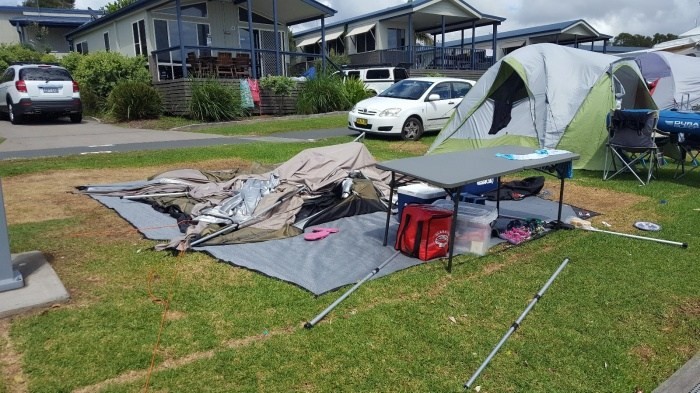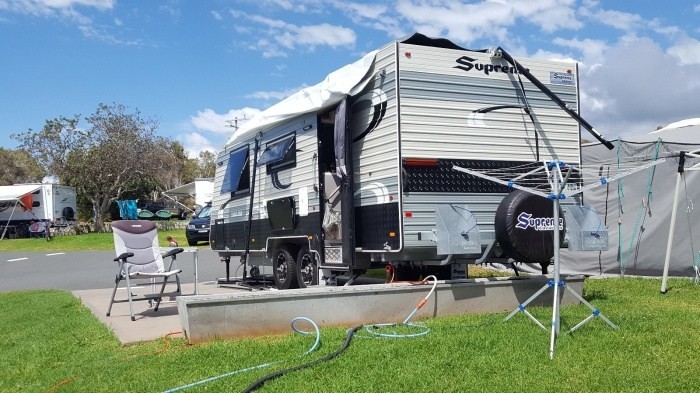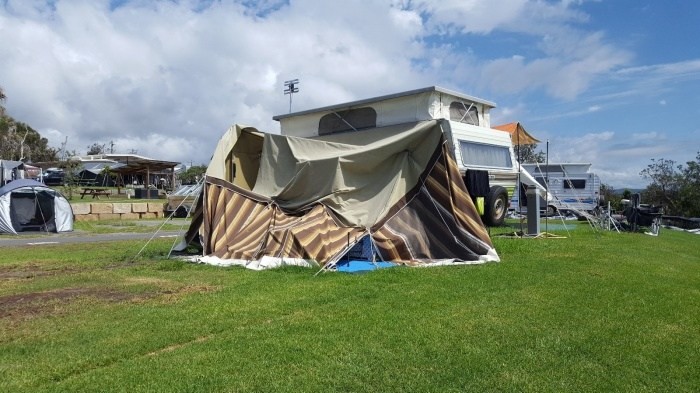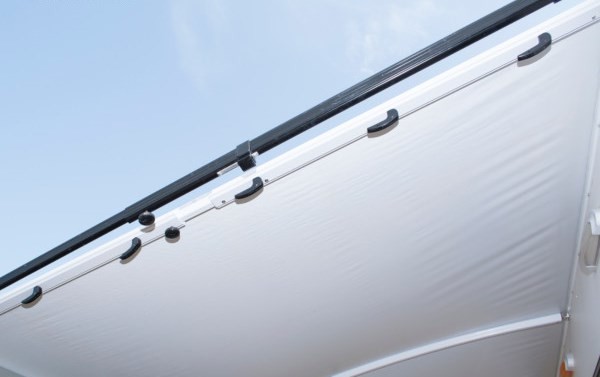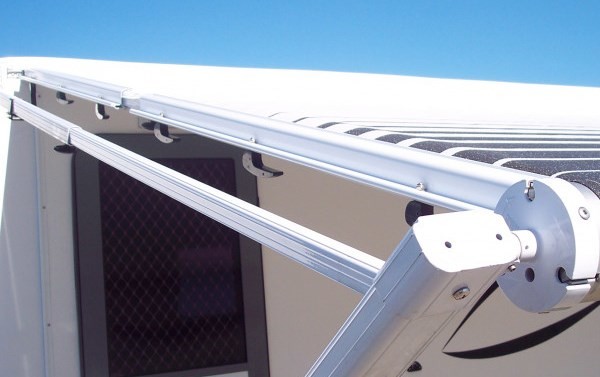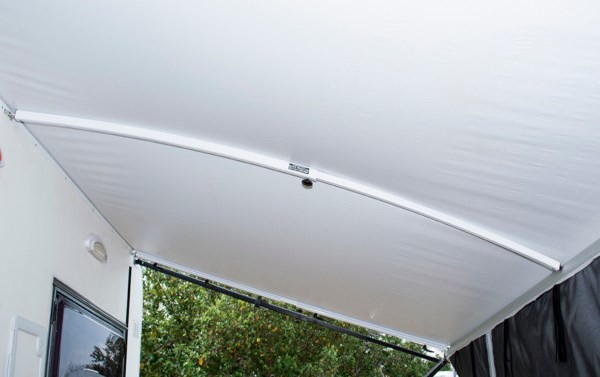The Rollout Awning
Modern caravans come with a roll out vinyl awning, which within its limitations is a fantastic simple and easy to use piece of equipment. Long gone are the heavy old canvas awnings with their impossible collection of poles, ropes, pegs and ample helping of frustration. The most common awning brands around the caravan parks will be Dometic and Carefree.
A typically roll out caravan awning is manually operated much like a huge holland blind. The obvious differences are its size and where a holland blind has an automatic positional lock and simple pull down to allow it to retract, the roll out awning has a locking lever on the end of the barrel which needs to flipped to allow it to retract. But all in all very similar, so its already something most people are fundamentally familiar with.
The different brands of manually operated awnings work similarly and relatively simply. The only difference will generally be the varying locations of the knobs, buttons and handles.
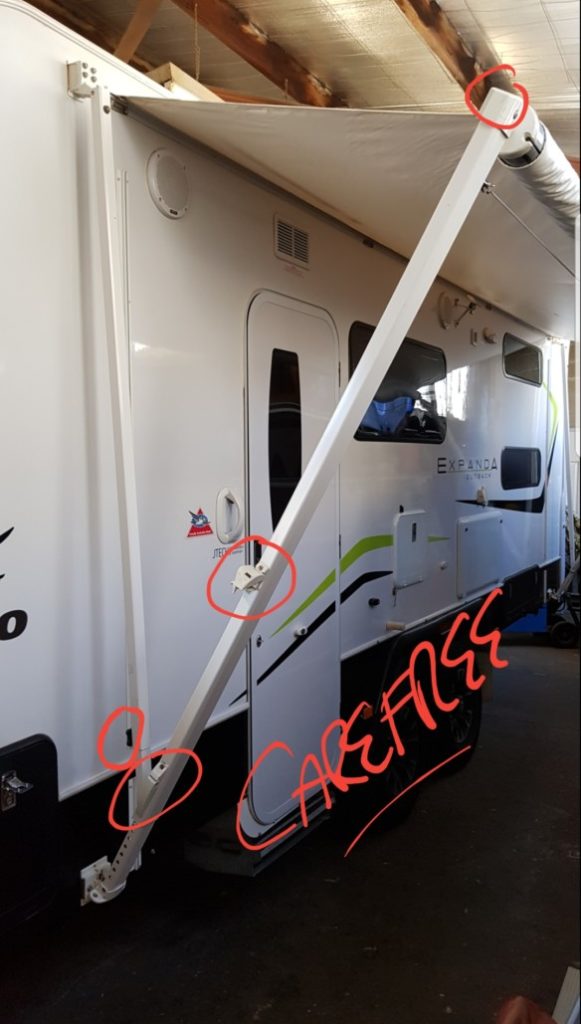
Location of Carefree awning controls 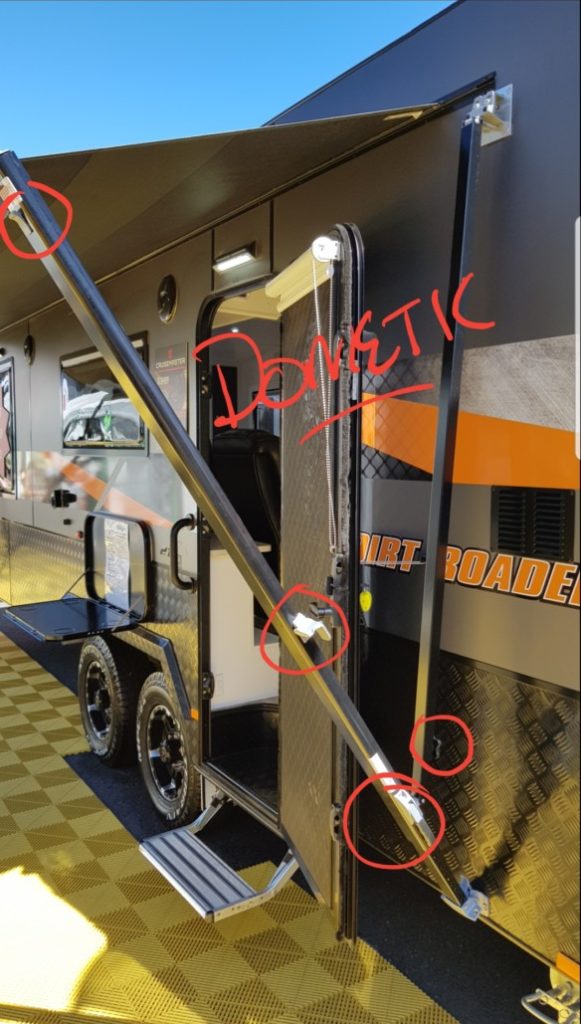
Location of Dometic awning controls
Its difficult to describe the deploy and retrieval process in text, so we’ve added videos to visualise the process.
There are additional after market components offered by 3rd party manufacturers. These components, the Aussie Traveller Anti Flap kit (AFK) and awning rafters are commonly regarded as essential additions by most experienced vanners. These 3rd party components strengthen and stabilise the awning against the effects of strong wind, and string wind is the arch nemesis of the roll out awning. In my opinion the AFK and rafters should be included as standard with every awning sold.
If you have an annex on a modern caravan you’ll likely already have the AFK (and rafters) because the AFK bars are the where most annex front and rear short walls are attached. The AFK provides both the attachment point and the weather proof seal between the awning vinyl and the annex front and rear walls.
The best advice I could possibly offer in relation to deploying and retrieving the awning is to familiarise yourself intimately with the process and the mechanisms. Practice and routine is the key here, so treat each routine camp site awning retrieval as an opportunity to hone and sharpen your procedures until it requires no conscious thought, and its a smooth and quick procedure.
When that surprise squall comes through you’ll be very glad that you are well practised and prepared. The last thing you’ll want is to find yourself in a position where your battling the awning against a strong wind and trying to save it from destruction, armed only with half arsed knowledge fuelled by nothing more than blind panic.
If you do enough camping, you’ll inevitably find yourself in a position where you’ll be exposed to storms, strong winds, and unexpected violent squalls. At some point you will need to quickly retrieve the awning in less than favourable conditions, so take the routine breaking of camp as an opportunity to practice getting this task right.
Surprise winds commonly spring up, and we’ve experienced our share of storms, and violent squalls. We were sitting in our van on the north east coast on a dead still, muggy evening chowing down on a bag of chips watching the TV. We were camped high up overlooking a beach in a caravan park and the weather had been humid and calm for days without a breath of breeze. Completely out of nowhere a massive and frightening wind squall hit us without so much as a hint of warning. My initial thought was the van had been hit by a car it was so fast and furious.
Quick thinking and our well practised team awning retrieval is what saved our awning from guaranteed destruction. Many others throughout the camp area that night including our neighbours weren’t so lucky, and many fumbled about making it far worse.
On the NSW mid north coast we’d rolled our awning in as a storm front and strong winds ripped through the camp area throwing branches and all sorts of stuff all over the place. We were leaving the following morning anyway and we stopped at the picturesque Bonny Hills on our way north to Port Macquarie to inspect the caravan park for future reference.
Bonny Hills is very exposed to the ocean winds and we witnessed the aftermath there of the storm we had copped 8km south the evening before. The carnage was substantial to many camps. What appeared to be new van had the awning torn off and thrown over the roof of the van, which had the potential then to impact other van and camps. Unfortunately they didn’t have an AFK, rafters or guy ropes in use.
The Aussie Traveller Anti Flap kits (AFK) are solid metal bars that fit between van body and the deployed awning roller barrel. They bars follow the line of the awning and clamp along the entire edge of the awning eliminating wind flap on the awning edges. Awning rafters lift the otherwise sagging awning material and work with the AFK to significantly strengthen and stabilise the awning through the middle.
Its the flapping and violent thumping of an unsupported awning in heavy wind that will beat itself to death. Stabilising the awning with the the AFK, rafter and guys ropes on either end of the barrel will stop more of the damaging movement of the awning in wind
With the awning deployed, AFK attached and rafter in place, a guy rope can also be added to each end of the awning barrel to anchor the awning barrel to the ground and complete the entire package. You will often see guys on awning barrels, particularly on the vans of the better prepared vanners.
Some folk attached the guy ropes on too large an angle, anywhere upto 45 deg much as you would on a tent. With an awning arms attached to the van top and bottom via the main and upper awning arms, wind forces will be vertical on the barrel so anchoring the barrel guys ropes closer to vertical is a better option. We chose to run our guy ropes on the same slight angle following the edge of the sunshade mesh if its attached or along the imaginary line if it’s not attached
Awning rafters perform a very important roll. Take the time to read our article (and watch the video) on Awning Rafters in the Equipment tab before you search for and purchase your own awning rafters.
The combined set up time required for both the AFK and the rafters will add less than a few minutes to your overall camp set up time (and pack up time). The significant value you will get from the use of these components will be far in excess of that few minutes you invest in their fitment and use.
Its a typical and amusing tale when as soon as wind and rain appear at a caravan park or camp ground, you will immediately hear the sounds of the Half Arsed Camp Pitcher. That sound is the clinking of tent pegs being struck across the camp area. The reason your hearing this is because people arrive in lovely sunshine and take a half arsed approach to their camp set up, only to be forced to complete that set up in the wind and the rain.
There is no point having the equipment if you aren’t going to use it … proper and complete camp set up is a good habit to get into.
I would strongly recommend that you use the AFK and rafter components every time you deploy the awning particularly if you have intentions of leaving it deployed, or are digging in for an extended stay.
On those occasions where we choose not to attached the AFK and awning rafters such as overnighter, truck stops, roadhouses etc, we will roll the awning in when we leave camp for any period of time or when we go to bed. The single biggest advantage of the roll out awning is the ease of deployment or retrieval, so there is no excuse when it comes to protecting your investment.
When we freecamp, if it’s at all possible we will generally make every effort to find a spot where we can position the caravan in such a way that the van itself provides the best kerb side shade at the hottest part of the day, and that will often negate the requirement of deploying the awning at all.
